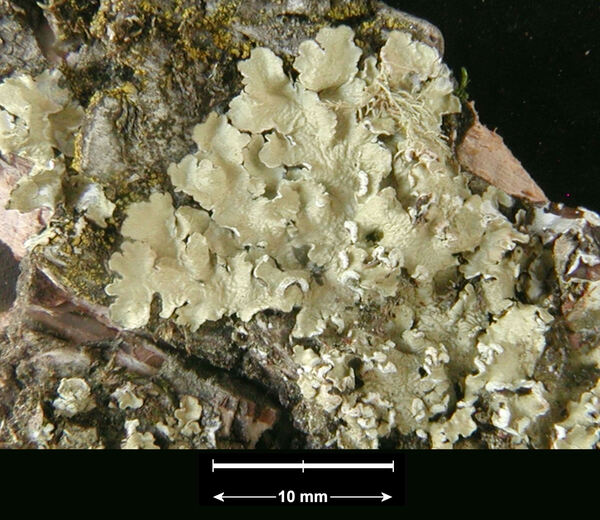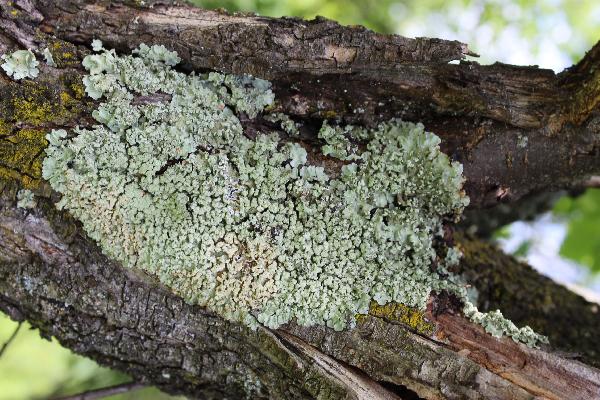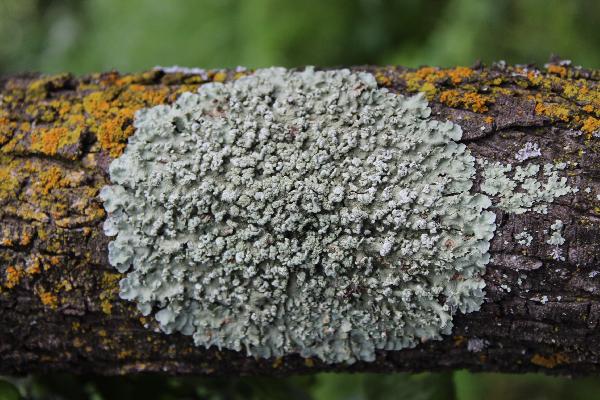Flavopunctelia soredica (Nyl.) Hale
Mycotaxon, 20: 682, 1984. Basionym: Parmelia soredica Nyl. - Flora, 68: 605, 1885.
Synonyms: Parmelia manshurica Asahina; Parmelia ulophyllodes (Vain.) Savicz; Punctelia soredica (Nyl.) Krog
Distribution: N - TAA (Nascimbene 2005b, 2006c, 2014, Nascimbene & al. 2007b, 2014), Lomb.
Description: Thallus foliose, heteromerous, dorsiventral, appressed to tightly adnate, forming up to 10(-12) cm wide rosettes. Lobes contiguous, flat, 3-8(-10) mm wide, with rounded apices. Upper surface yellowish green, turning brownish in the herbarium, smooth to weakly wrinkled, frequently white-maculate but rarely with true, very small, punctiform pseudocyphellae. Soredia white, farinose to granular, arranged into crescent- to lip-shaped soralia along the reflexed, wavy lobe margins, rarely also laminal. Lower surface smooth to finely wrinkled, dark brown at margin, black in central parts, with simple or rarely forked, short, dark rhizines which usually lack in a narrow marginal zone. Upper cortex paraplectenchymatous, with a non-pored epicortex, the cell walls with an intermediate type of lichenan; medulla white; algal layer continuous; lower cortex paraplectenchymatous. Apothecia rare, lecanorine, with a brown disc and an often sorediate thalline margin. Epithecium brownish; hymenium and hypothecium colourless. Asci 8-spored, clavate, Lecanora- type. Ascospores 1-celled, hyaline, ellipsoid, 9-12 x 5-7 µm. Pycnidia rare, black. Conidia straight, bifusiform or almost thread-like, 7-11 µm long. Photobiont chlorococcoid. Spot tests: upper cortex K+ yellowish, KC- or KC+ pale yellow, C-, P-; medulla K-, C+ red, KC+ red, P-. Chemistry: upper cortex with usnic acid; medulla with lecanoric acid (major) and 5-chlorolecanoric acid (minor or trace).Note: a mainly epiphytic species, restricted to Alpine valleys with a continental climate, certainly very rare in Italy. It is included in the Italian red list of epiphytic lichens as “Endangered” (Nascimbene & al. 2013c).
Growth form: Foliose, broad lobed
Substrata: bark
Photobiont: green algae other than Trentepohlia
Reproductive strategy: mainly asexual, by soredia, or soredia-like structures (e.g. blastidia)
Subcontinental: restricted to areas with a dry-subcontinental climate (e.g. dry Alpine valleys, parts of Mediterranean Italy)
Commonnes-rarity: (info)
Alpine belt: absent
Subalpine belt: very rare
Oromediterranean belt: absent
Montane belt: very rare
Submediterranean belt: absent
Padanian area: absent
Humid submediterranean belt: absent
Humid mediterranean belt: absent
Dry mediterranean belt: absent

Predictive model
Herbarium samples
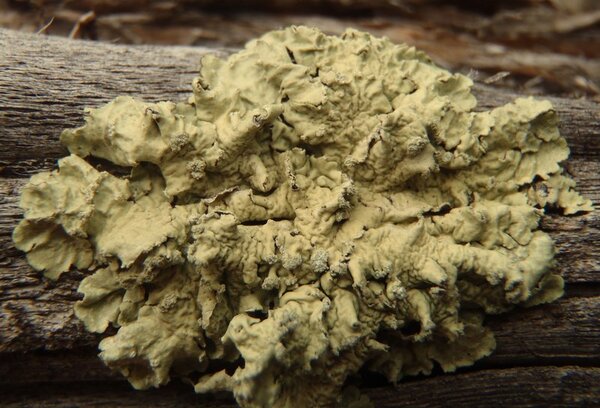

Curtis Randall Björk – CC BY-SA 4.0
British Columbia, Lac du Bois Grasslands near Kamloops Date: 2011-09-01 On stems of Artemisia tridentata in sagebrush steppe
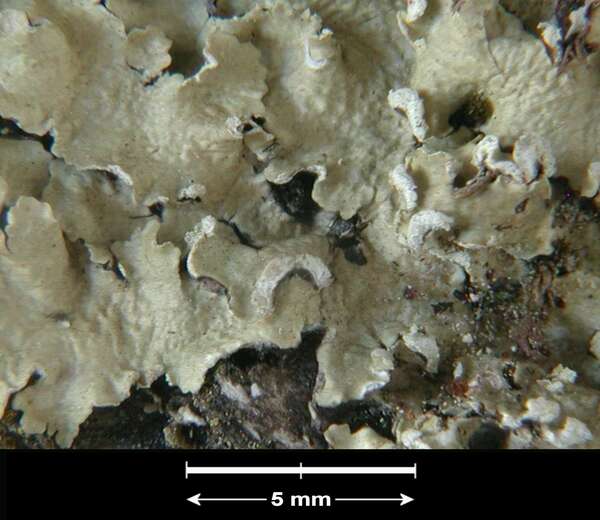

G. Incerti; Owner: Department of Life Sciences, University of Trieste
Herbarium: TSB (29022)
2001/11/26
lobes with soredia

Ulrich Kirschbaum CC BY-SA 4.0 - Source: https://www.thm.de/lse/ulrich-kirschbaum/flechtenbilder
Namibia: Waterberg region. (Identified by V. Wirth).
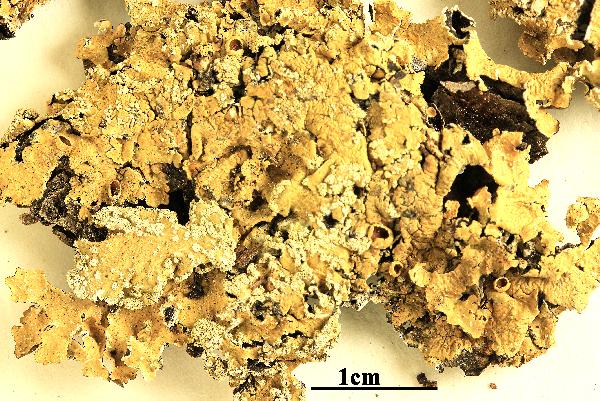

Felix Schumm - CC BY-4.0
[VZR15], USA. Texas. Jeff Davis County: in montibus Davis Maoutains,
ad septentriones et occidentem versus Fort Davis, loco "Lawrence
E. Wood Picnic Area" secus viam dictam Route 118, 1525 m. Ad
corticem truncorum Pini sp.. Leg. W. L. Culberson (no. 22145) et R.
Ornduff, 11.8.1991 - Annot.: Usnic acid, lecanoric acid, and trace of
unknown pigment by TLC, anal. A. Johnson & F. C. Culberson. EX A.
VEZDA: LICHENES RARIORES EXSICCATI NR. 15.


Felix Schumm - CC BY-4.0
[VZR15], USA. Texas. Jeff Davis County: in montibus Davis Maoutains,
ad septentriones et occidentem versus Fort Davis, loco "Lawrence
E. Wood Picnic Area" secus viam dictam Route 118, 1525 m. Ad
corticem truncorum Pini sp.. Leg. W. L. Culberson (no. 22145) et R.
Ornduff, 11.8.1991 - Annot.: Usnic acid, lecanoric acid, and trace of
unknown pigment by TLC, anal. A. Johnson & F. C. Culberson. EX A.
VEZDA: LICHENES RARIORES EXSICCATI NR. 15.
Growth form: Foliose, broad lobed
Substrata: bark
Photobiont: green algae other than Trentepohlia
Reproductive strategy: mainly asexual, by soredia, or soredia-like structures (e.g. blastidia)
Subcontinental: restricted to areas with a dry-subcontinental climate (e.g. dry Alpine valleys, parts of Mediterranean Italy)
Commonnes-rarity: (info)
Alpine belt: absent
Subalpine belt: very rare
Oromediterranean belt: absent
Montane belt: very rare
Submediterranean belt: absent
Padanian area: absent
Humid submediterranean belt: absent
Humid mediterranean belt: absent
Dry mediterranean belt: absent

Predictive model
| Herbarium samples |


Curtis Randall Björk – CC BY-SA 4.0
British Columbia, Lac du Bois Grasslands near Kamloops Date: 2011-09-01 On stems of Artemisia tridentata in sagebrush steppe


G. Incerti; Owner: Department of Life Sciences, University of Trieste
Herbarium: TSB (29022)
2001/11/26
lobes with soredia

Ulrich Kirschbaum CC BY-SA 4.0 - Source: https://www.thm.de/lse/ulrich-kirschbaum/flechtenbilder
Namibia: Waterberg region. (Identified by V. Wirth).


Felix Schumm - CC BY-4.0
[VZR15], USA. Texas. Jeff Davis County: in montibus Davis Maoutains, ad septentriones et occidentem versus Fort Davis, loco "Lawrence E. Wood Picnic Area" secus viam dictam Route 118, 1525 m. Ad corticem truncorum Pini sp.. Leg. W. L. Culberson (no. 22145) et R. Ornduff, 11.8.1991 - Annot.: Usnic acid, lecanoric acid, and trace of unknown pigment by TLC, anal. A. Johnson & F. C. Culberson. EX A. VEZDA: LICHENES RARIORES EXSICCATI NR. 15.


 INDEX FUNGORUM
INDEX FUNGORUM
 GBIF
GBIF
 DOLICHENS
DOLICHENS
